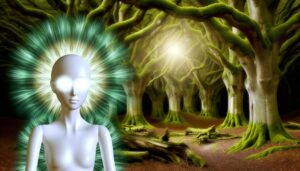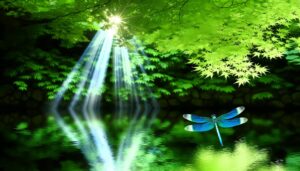Color Green Spiritual Meaning Bible: Life and Renewal
In biblical literature, the color green embodies profound spiritual meanings, often symbolizing life, growth, and divine provision. Scriptural references, such as Genesis 2:8-9 and Psalm 23:2, highlight lush vegetation and green pastures that signify God’s providence, tranquility, and spiritual nourishment.
Additionally, green is associated with healing and renewal, as depicted in Ezekiel 47 with restorative green trees. Prophetic visions, like those in Revelation 4:3, and parables, such as the budding fig tree in Matthew 24:32, employ green to illustrate divine wisdom and the promise of eternal life.
Exploring these themes can offer deeper understanding of biblical truths.
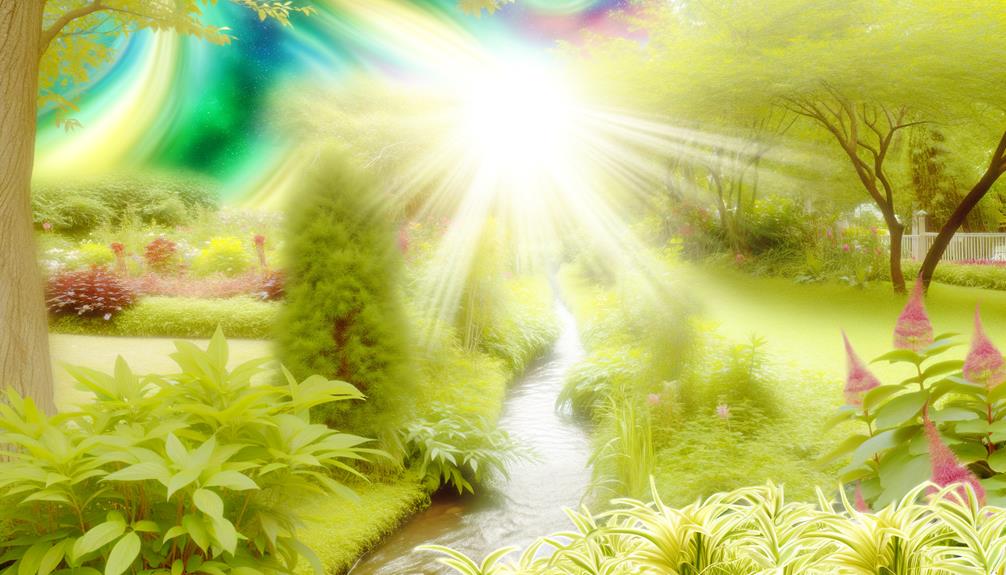
Color Green Spiritual Meaning in the Bible: Life, Renewal, and Prosperity
| Biblical Aspect | Spiritual Meaning |
|---|---|
| Symbol of Life | Renewal, vitality, divine creation |
| Associated Themes | Growth, hope, abundance, peace |
| Scriptural Connection | Psalm 23:2 – “He makes me lie down in green pastures” |
| Emotional Impact | Comfort, peace, spiritual rest |
| Spiritual Message | God’s provision, healing, and flourishing soul |
Green in Genesis
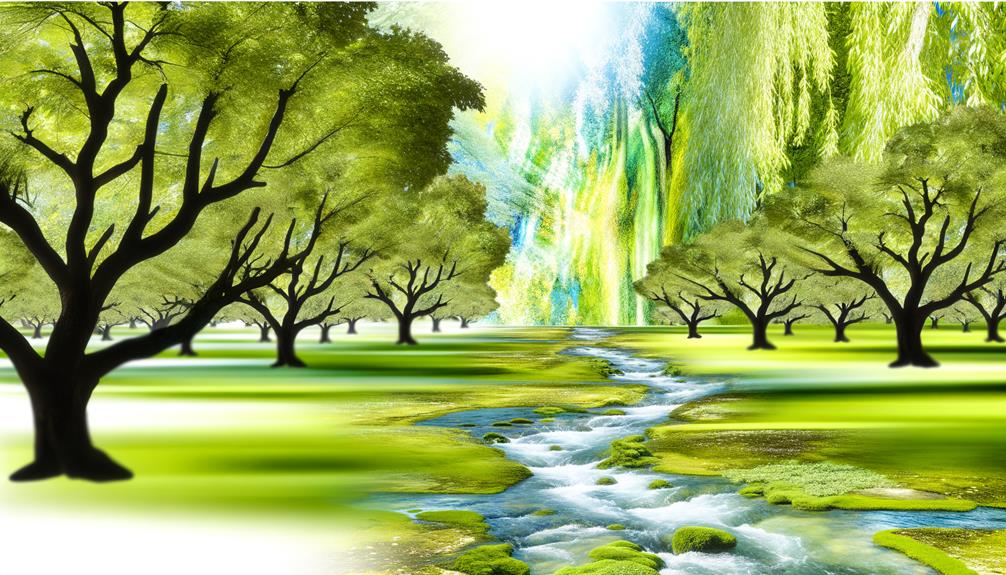
In the Book of Genesis, the color green is emblematic of life, growth, and divine creation, prominently showcased in the depiction of the Garden of Eden.
This verdant paradise, described in Genesis 2:8-9, is replete with lush vegetation, symbolizing not only physical sustenance but also spiritual significance.
The flourishing greenery underscores God’s providence and the harmonious relationship between humanity and nature prior to the Fall.
Green, thus, transcends its literal meaning, embodying the essence of divine benevolence and fecundity.
The Edenic imagery invites readers to contemplate the interconnectedness of creation, the Creator’s generosity, and humanity’s role within this divine order.
Through this lens, Genesis positions green as a profound symbol of divine generosity and the intrinsic sanctity of life.
Symbolism of Pastures
The symbolism of pastures in spiritual discourse often embodies themes of restoration and peacefulness, reflecting the tranquility and sustenance provided by verdant landscapes.
Scriptural references, such as Psalm 23, underscore pastures as a divine provision, where the green expanse signifies God’s nurturing care and abundant blessings.
Consequently, the color green in the context of pastures becomes a powerful metaphor for spiritual renewal and divine benevolence.
Restoration and Peacefulness
Pastures, often depicted as verdant and expansive, symbolize restoration and peacefulness in various spiritual traditions. Within the biblical context, green pastures serve as metaphors for divine rejuvenation and tranquility, reflecting God’s nurturing care for His followers. The serene imagery of lush fields evokes a sense of comfort and renewal, foundational to the spiritual experience.
- Psalm 23:2 – ‘He makes me lie down in green pastures. He leads me beside quiet waters.’
- Ezekiel 34:14 – God promises to feed His flock in good pastures.
- Symbol of Renewal – Green pastures signify spiritual and physical renewal.
- Peacefulness – The tranquility of pastures reflects inner peace.
Such symbolism underscores the profound connection between nature and divine peace.
Divine Provision
Divine provision is vividly embodied in the symbolism of green pastures, representing God’s promise to sustain and nurture His followers.
In Psalm 23:2, David articulates, ‘He makes me lie down in green pastures,’ metaphorically illustrating divine care and abundance. The green pastures signify not only physical sustenance but also spiritual nourishment, reflecting God’s unwavering commitment to the well-being of His people.
This imagery evokes a landscape of fertility and life, underscoring the Lord’s role as a shepherd who provides all that is necessary. Additionally, green pastures are emblematic of rest and safety, environments where believers can find solace and rejuvenation.
Through this symbolism, the Bible reassures the faithful of God’s perpetual provision and protection.
Healing and Restoration
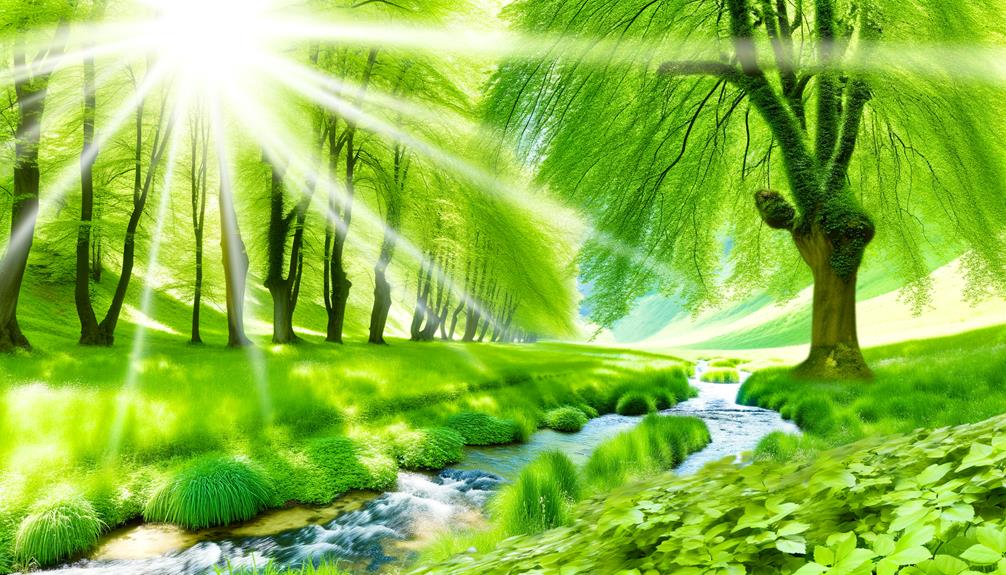
Throughout various spiritual traditions, the color green is often associated with profound healing and the restoration of both physical and emotional well-being.
In biblical contexts, green signifies life, renewal, and God’s nurturing presence. This symbolism can be seen through:
- Green Pastures: Representing tranquility and divine care, as noted in Psalm 23.
- Healing Herbs: Utilized in ancient medicinal practices, symbolizing God’s provision for health.
- Ezekiel’s Vision: The lush, green trees in Ezekiel 47 depict restoration and divine promise.
- Resurrection Imagery: Green embodies new life and the promise of restoration through Christ.
These elements collectively underscore green’s profound connection to healing and restoration in biblical theology.
Green in Psalms
The color green, prominently featured in the Psalms, serves as a metaphor for spiritual nourishment and divine provision, resonating with themes of healing and restoration previously discussed.
In Psalm 23:2, the psalmist writes, ‘He makes me lie down in green pastures,’ symbolizing peace and sustenance provided by God.
Similarly, Psalm 52:8 states, ‘But I am like a green olive tree in the house of God,’ illustrating the believer’s flourishing under divine care.
These passages underscore the verdant imagery as a representation of God’s unending faithfulness and the spiritual liveliness bestowed upon the faithful.
Consequently, the Psalms utilize green to evoke a sense of perpetual growth, renewal, and the abundant life that stems from divine fellowship.
Prophetic Imagery
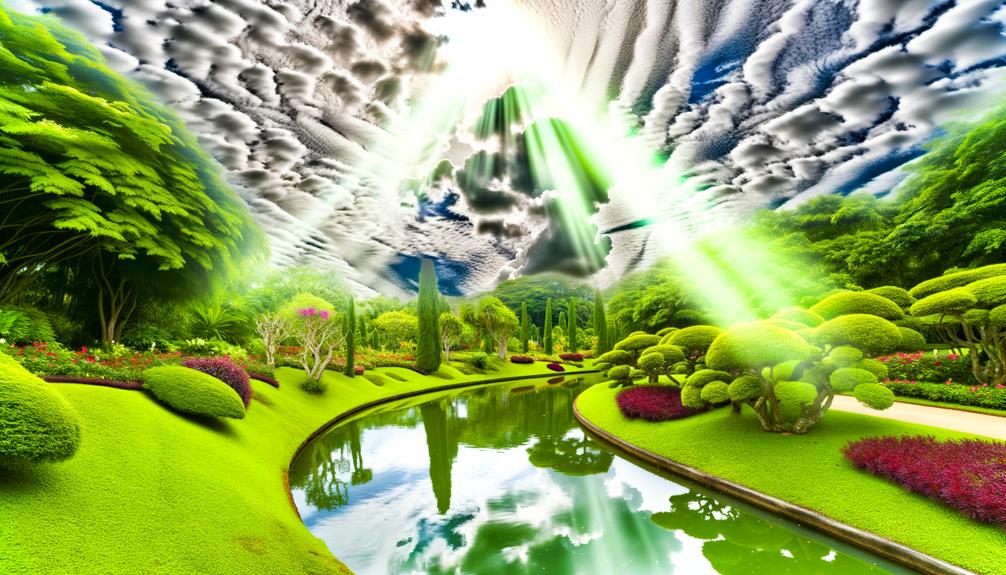
In prophetic imagery, the color green frequently symbolizes renewal, life, and divine promise, permeating various scriptural visions and revelations.
For instance, the lush, green pastures mentioned in Ezekiel’s prophecies (Ezekiel 34:14) evoke a sense of divine provision and restoration.
Such symbolism underscores the theological significance of green as a representation of God’s ongoing covenant and the flourishing of spiritual life.
Symbolism in Scripture
Within scriptural texts, the color green frequently symbolizes life, renewal, and divine blessing, serving as a powerful prophetic imagery. This symbolic resonance is deeply rooted in various biblical narratives and passages. Green often represents the flourishing of God’s creation and the abundance of His provisions. It is used to convey messages of hope, growth, and the perpetuity of His covenant with humanity.
- Psalm 23:2: ‘He makes me lie down in green pastures,’ symbolizing peace and sustenance.
- Ezekiel 17:24: Green trees as a metaphor for nations and their fortunes.
- Revelation 4:3: The emerald rainbow, signifying God’s eternal promise.
- Psalm 1:3: The righteous as trees planted by streams, always green.
- Jeremiah 17:8: Trust in the Lord, likened to a tree with green leaves.
Visions and Revelations
Prophetic visions and revelations often employ the color green as a symbol of divine presence, spiritual renewal, and the promise of everlasting life.
In scriptural narratives, green landscapes frequently signify God’s provision and care, as seen in Psalm 23:2, ‘He makes me lie down in green pastures.’ This imagery underscores a serene environment where divine guidance is prominent.
Similarly, the emerald rainbow encircling God’s throne in Revelation 4:3 highlights the eternal covenant and the unending grace of God.
The recurrent use of green in prophetic texts consequently serves to convey messages of hope, restoration, and divine fidelity, providing believers with a visual affirmation of God’s continuous engagement with humanity and His commitment to their spiritual flourishing.
Green in Parables
Parables often employ the color green to symbolize growth, renewal, and divine wisdom, drawing on its rich scriptural associations. This symbolic usage underscores themes of spiritual development and the nurturing of faith, resonating deeply within biblical narratives. Green, as portrayed in parables, serves as a metaphor for the flourishing of righteousness and the continual guidance of God’s wisdom.
- Green pastures in Psalm 23 signify divine provision and spiritual rejuvenation.
- The budding fig tree in Matthew 24:32 represents awareness and readiness for divine events.
- Fertile land in the Parable of the Sower (Matthew 13) illustrates receptive hearts to God’s word.
- Fresh olive leaves in Noah’s story (Genesis 8:11) symbolize hope and renewal.
- The evergreen tree in Jeremiah 17:8 denotes steadfast faith and prosperity.
Eternal Life
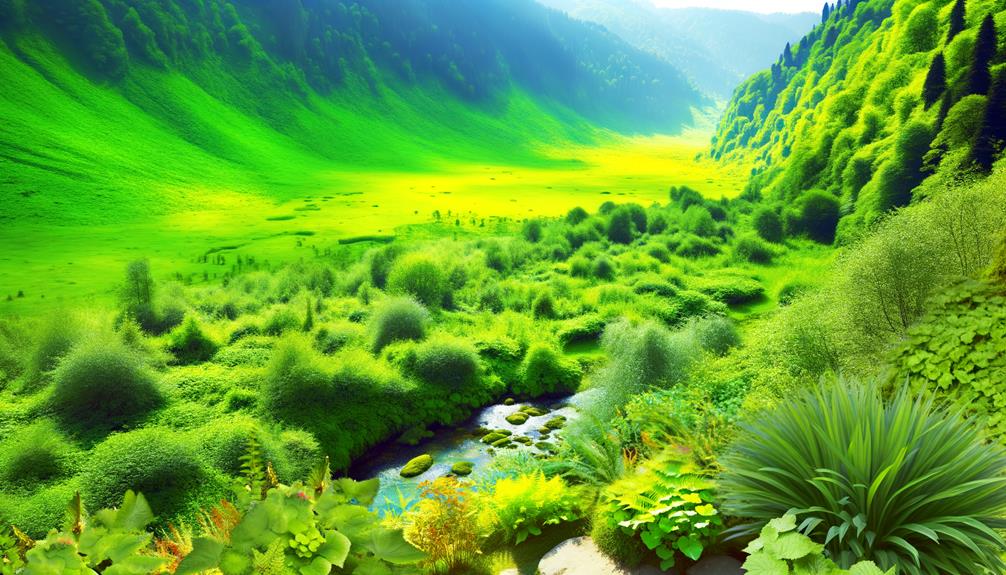
The color green, often associated with energy and renewal, holds profound significance in theological discussions of eternal life, symbolizing the promise of everlasting spiritual rejuvenation and divine immortality.
In biblical texts, green appears as a metaphor for life that transcends temporal existence, as seen in Psalm 23:2, where ‘green pastures‘ represent divine provision and rest.
Additionally, Revelation 22:2 speaks of the ‘tree of life‘ bearing perpetual fruit, its leaves symbolizing healing and eternal sustenance.
Green therefore embodies the continuous, unending nature of eternal life, reflective of God’s unwavering grace and the believer’s ultimate union with the divine.
This chromatic symbolism elucidates green’s role in portraying the hope and assurance of an eternal, spiritually enriched existence.
Promise of Abundance
In scriptural contexts, green frequently symbolizes the promise of divine abundance, reflecting God’s provision and the flourishing of life under His care.
This color is often associated with the fertile landscapes and bountiful harvests described in the Bible, symbolizing God’s ability to provide both spiritual and material sustenance.
The imagery of green pastures in Psalm 23 epitomizes tranquility and divine care, further emphasizing the theme of providence.
- Psalm 23:2: ‘He makes me lie down in green pastures.’
- Genesis 1:30: Provision of green plants for sustenance.
- Mark 6:39: Jesus instructs people to sit on the green grass.
- Ezekiel 34:14: God promises abundant pasture for His flock.
Conclusion
The color green in the Bible carries profound spiritual significance, embodying themes of creation, renewal, and divine providence. In addition to its association with new beginnings, green also symbolizes growth and fertility, often reflecting God’s promise of sustenance and life. The spiritual significance of colors in the Bible extends beyond green, as each hue conveys deeper meanings that enrich the understanding of divine messages. By exploring these colors, believers can gain insight into the multifaceted nature of God’s creation and His ongoing presence in the world. Alongside green, the spiritual significance of the color red is also noteworthy, representing both sacrifice and love, often linked to the blood of Christ and His atonement for humanity. This duality in color symbolism enhances the rich tapestry of biblical teachings, illustrating the balance between creation and redemption. By reflecting on these colors, individuals are invited to deepen their faith and understanding of the spiritual journey they are called to undertake. In contrast to the vibrancy of green, the spiritual significance of the color gray often denotes humility, neutrality, and the transition between life stages. This muted color serves as a reminder of the balance between joy and sorrow, reflecting the complexities of the human experience in relation to the divine. By contemplating the spiritual meanings of various colors, individuals can deepen their faith and enhance their understanding of the tapestry of life crafted by God. In contrast to green, the spiritual significance of the color yellow highlights themes of joy, hope, and illumination. It often represents the light of God’s presence and the radiance of faith that enlightens the hearts of believers. By examining the spiritual significance of the color yellow alongside green, one can appreciate the vibrant tapestry of meanings that colors bring to biblical teachings. Among these hues, the spiritual significance of colors often highlights the connection between the physical and spiritual realms, guiding believers in their journey of faith. Each color serves as a reminder of God’s attributes and the messages He communicates through His creation. By understanding the spiritual significance of colors, individuals can deepen their relationship with the divine and enhance their worship experience.
From the verdant pastures in Genesis to the restorative imagery in Psalms, green symbolizes healing, abundance, and eternal life.
How can one overlook the prophetic and parabolic use of green as a divine promise of sustenance and growth?
Through scriptural analysis, green emerges as a powerful emblem of God’s unwavering commitment to humanity’s spiritual and physical well-being.

